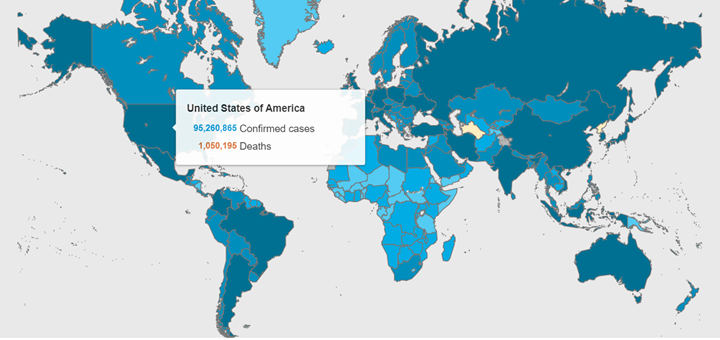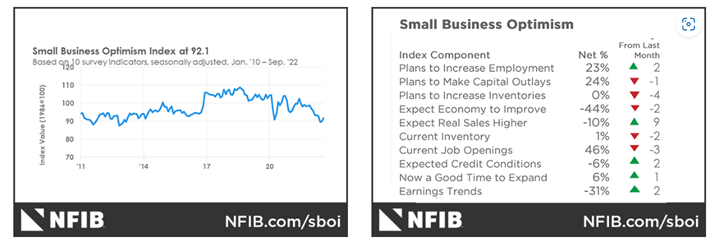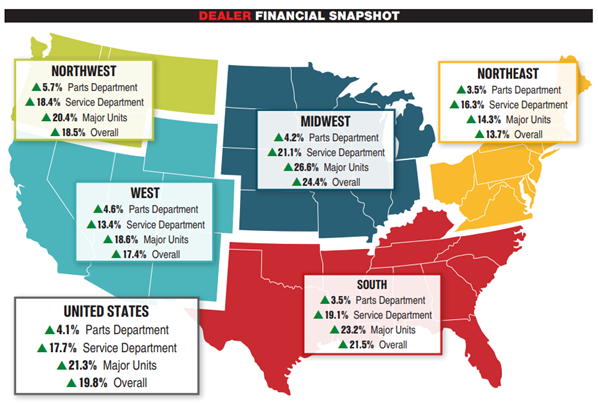KPI — October 2022: The Brief

More than 617.5 million COVID-19 cases and 6.5 million deaths are confirmed across the globe. Vaccination efforts remain a top priority among health and government officials, with an ultimate goal of reaching herd immunity. Approximately 68% of Americans are fully vaccinated, according to recent CDC data. Experts estimate 70%-85% of the population must be vaccinated in order to reach herd immunity. As of mid-September, 604,511,670 vaccine doses have been administered.
To date, nearly 96 million cases were reported across the U.S, with California, Texas and Florida claiming the highest numbers, according to Statista. COVID-19 restrictions vary by state, county and even city. Review a comprehensive list of current restrictions here.
COVID-19 Cases by Country

The Conference Board Consumer Confidence Index® edged up in September for the second consecutive month. The Index now stands at 108.0 (1985=100), up from 103.6 in August. The Present Situation Index – based on consumers’ assessment of current business and labor market conditions – rose to 149.6 from 145.3 last month. The Expectations Index – based on consumers’ short-term outlook for income, business and labor market conditions – increased to 80.3 from 75.8.
The Consumer Sentiment Index – a survey consisting of approximately 50 core questions covering consumers’ assessments of their personal financial situation, buying attitudes and overall economic conditions – remained relatively unchanged at 58.6 in September, according to the University of Michigan Survey of Consumers.
“Inflation expectations are likely to remain relatively unstable in the months ahead, as consumer uncertainty over these expectations remained high and is unlikely to wane in the face of continued global pressures on inflation,” says Joanne Hsu, director at Survey of Consumers.
Small businesses are feeling the pressure, too. While the NFIB Small Business Optimism Index rose 0.3 points in September to 92.1, it marks the ninth consecutive month below the 48-year average of 98. Moreover, 30% of owners reported inflation as their single most important problem in business operations.
“Inflation and worker shortages continue to be the hardest challenges facing small business owners,” says Bill Dunkelberg, NFIB chief economist. “Even with these challenges, owners are still seeking opportunities to grow their business in the current period.”
Key Data Points, Courtesy of NFIB:
- Small business owners expecting “better business conditions” over the next six months improved 10 points from July to a net negative 42%, the highest level since February 2022 but an underperforming outlook.
- The net percent of owners raising average selling prices decreased three points to a net 53% (seasonally adjusted) – still reflective of inflation.
- Plans to fill open positions remain elevated, with a seasonally adjusted net 23% of planning to create new jobs in the next three months. Of those owners trying to hire, 89% reported few or no qualified applicants to fill open positions.
- Thirty-two percent of owners reported supply chain disruptions as a significant impact on business operations. Thirty-four percent noted a moderate impact and 22% a mild impact. Only 10% of owners indicated no impact from recent supply chain disruptions.
- The Uncertainty Index increased seven points to 74.

Professionals in the automotive, RV and powersports industries remain steadfast in their efforts to evolve their business models and grow their brands in the face of adversity. As such, the monthly Key Performance Indicator Report serves as an objective wellness check on the overall health of our nation, from the state of manufacturing and vehicle sales to current economic conditions and consumer trends. Below are a few key data points explained in further detail throughout the report:
This Month’s Top Takeaways:
- The September Manufacturing PMI® registered 50.9, 1.9 percentage points lower than the 52.8 percent recorded in August, according to supply executives in the latest Manufacturing ISM® Report On Business®.
- The Consumer Price Index for All Urban Consumers (CPI-U) rose 0.4% in September on a seasonally adjusted basis after rising 0.1% in August, according to the the U.S. Bureau of Labor Statistics. Over the last 12 months, the all-items index increased 8.2% before seasonal adjustment.
- Total new vehicle sales for September 2022, including retail and non-retail transactions, are projected to reach 1,120,279 units – an 11.8% year-over-year increase. The seasonally adjusted annualized rate (SAAR) for total new vehicle sales is expected to hit 13.6 million units, up 1.5 million units compared to 2021, according to a joint forecast from J.D. Power and LMC Automotive.
- RV wholesale shipments are projected to reach 498,800 units by year-end 2022 – a 16.9% decline from the record 600,240 shipped in 2021, according to the Fall 2022 issue of RV RoadSigns, the quarterly forecast prepared by ITR Economics for the RV Industry Association. Staring down the barrel at 2023, the forecast suggests shipments will range between 409,000 and 429,000 units, with a most likely year-end total of 419,000 – a 16% decline from this year’s projected total. “The softening economic backdrop, as measured by declines in ITR’s system of leading indicators, is impacting the RV shipment forecast,” reports RV PRO. “Coupled with lower savings rates, elevated inflation and higher interest rates, these factors are putting pressure on consumer budgets, leading some to reduce or postpone spending on discretionary items such as RVs.”
- Powersports Business says many dealerships across the country reported year-over-year revenue growth (on average) in August. Every region posted an increase in parts, service and major unit sales revenue. The Northwest recorded the largest increase in parts sales with 5.7% growth. On average, parts revenue increased at dealerships by 4.1%. The service department for dealerships nationwide saw an “exceptional revenue growth,” averaging a 17.7% increase. The Midwest and the South saw the greatest increase in service revenue, while the West posted the least growth (yet still a considerable increase). Following suit, sales revenue from new and pre-owned units also grew significantly nationwide – averaging 21.3%. The Midwest and the South produced the largest revenue increase in that department, with the average dealership experiencing a 19.8% year-over-year bump increase. The Midwest saw the largest increase of 24.4% and the Northeast saw the lowest increase of 13.7%.

KPI — October 2022: State of Business — Automotive Industry
Key Performance Indicators Report — October 2022



